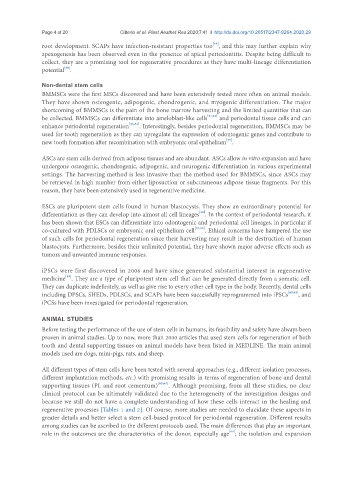Page 460 - Read Online
P. 460
Page 4 of 20 Citterio et al. Plast Aesthet Res 2020;7:41 I http://dx.doi.org/10.20517/2347-9264.2020.29
[49]
root development. SCAPs have infection-resistant properties too , and this may further explain why
apexogenesis has been observed even in the presence of apical periodontitis. Despite being difficult to
collect, they are a promising tool for regenerative procedures as they have multi-lineage differentiation
[50]
potential .
Non-dental stem cells
BMMSCs were the first MSCs discovered and have been extensively tested more often on animal models.
They have shown osteogenic, adipogenic, chondrogenic, and myogenic differentiation. The major
shortcoming of BMMSCs is the pain of the bone marrow harvesting and the limited quantities that can
be collected. BMMSCs can differentiate into ameloblast-like cells [51,52] and periodontal tissue cells and can
enhance periodontal regeneration [53,54] . Interestingly, besides periodontal regeneration, BMMSCs may be
used for tooth regeneration as they can upregulate the expression of odontogenic genes and contribute to
[55]
new tooth formation after recombination with embryonic oral epithelium .
ASCs are stem cells derived from adipose tissues and are abundant. ASCs allow in vitro expansion and have
undergone osteogenic, chondrogenic, adipogenic, and neurogenic differentiation in various experimental
settings. The harvesting method is less invasive than the method used for BMMSCs, since ASCs may
be retrieved in high number from either liposuction or subcutaneous adipose tissue fragments. For this
reason, they have been extensively used in regenerative medicine.
ESCs are pluripotent stem cells found in human blastocysts. They show an extraordinary potential for
[56]
differentiation as they can develop into almost all cell lineages . In the context of periodontal research, it
has been shown that ESCs can differentiate into odontogenic and periodontal cell lineages, in particular if
co-cultured with PDLSCs or embryonic oral epithelium cell [57,58] . Ethical concerns have hampered the use
of such cells for periodontal regeneration since their harvesting may result in the destruction of human
blastocysts. Furthermore, besides their unlimited potential, they have shown major adverse effects such as
tumors and unwanted immune responses.
iPSCs were first discovered in 2006 and have since generated substantial interest in regenerative
medicine . They are a type of pluripotent stem cell that can be generated directly from a somatic cell.
[59]
They can duplicate indefinitely, as well as give rise to every other cell type in the body. Recently, dental cells
including DPSCs, SHEDs, PDLSCs, and SCAPs have been successfully reprogrammed into iPSCs [60,61] , and
iPCSs have been investigated for periodontal regeneration.
ANIMAL STUDIES
Before testing the performance of the use of stem cells in humans, its feasibility and safety have always been
proven in animal studies. Up to now, more than 2000 articles that used stem cells for regeneration of both
tooth and dental supporting tissues on animal models have been listed in MEDLINE. The main animal
models used are dogs, mini-pigs, rats, and sheep.
All different types of stem cells have been tested with several approaches (e.g., different isolation processes,
different implantation methods, etc.) with promising results in terms of regeneration of bone and dental
supporting tissues (PL and root cementum) [62,63] . Although promising, from all these studies, no clear
clinical protocol can be ultimately validated due to the heterogeneity of the investigation designs and
because we still do not have a complete understanding of how these cells interact in the healing and
regenerative processes [Tables 1 and 2]. Of course, more studies are needed to elucidate these aspects in
greater details and better select a stem cell-based protocol for periodontal regeneration. Different results
among studies can be ascribed to the different protocols used. The main differences that play an important
[64]
role in the outcomes are the characteristics of the donor, especially age ; the isolation and expansion

